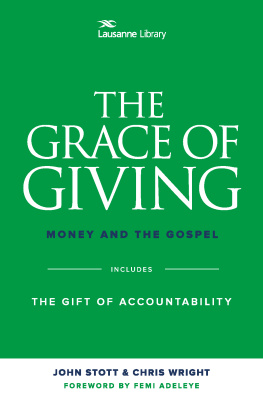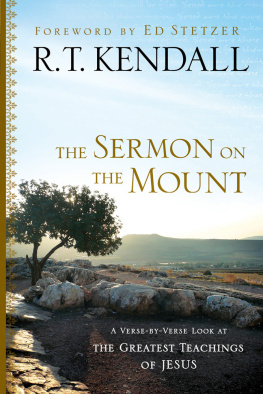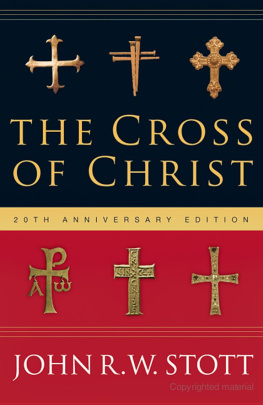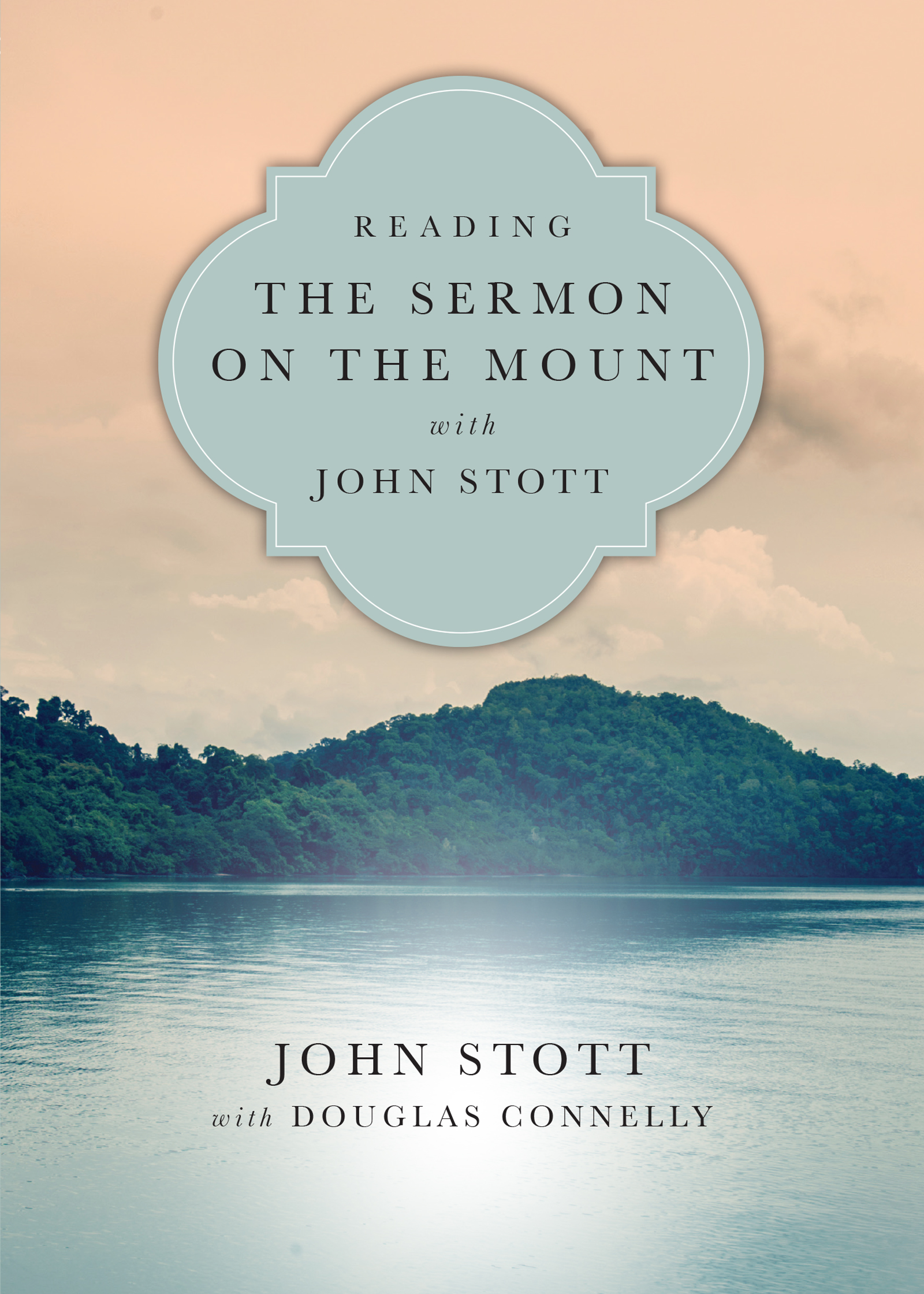InterVarsity Press
P.O. Box 1400, Downers Grove, IL 60515-1426
2016 John Stotts Literary Executors
All rights reserved. No part of this book may be reproduced in any form without written permission from InterVarsity Press.
This volume is abridged and edited from The Message of the Sermon on the Mount 1978 by John R. W. Stott, originally published under the title Christian Counter-Culture, by permission of Inter-Varsity Press, England. Some of the discussion questions are from The Beatitudes: Developing Spiritual Character 1998 by John R. W. Stott with Dale and Sandy Larsen, originally published by InterVarsity Press, Downers Grove, Illinois, USA.
InterVarsity Pressis the book-publishing division of InterVarsity Christian Fellowship/USA, a movement of students and faculty active on campus at hundreds of universities, colleges and schools of nursing in the United States of America, and a member movement of the International Fellowship of Evangelical Students. For information about local and regional activities, visit intervarsity.org .
All Scripture quotations, unless otherwise indicated, are taken from THE HOLY BIBLE, NEW INTERNATIONAL VERSION, NIVCopyright 1973, 1978, 1984, 2011 by Biblica, Inc.Used by permission. All rights reserved worldwide.
Cover design: Cindy Kiple
Images: fototrips/iStockphoto
ISBN 978-0-8308-9334-8 (digital)
ISBN 978-0-8308-3193-7 (print)
Library of Congress Cataloging-in-Publication Data
Names: Stott, John R. W., author. | Stott, John R. W. Christian counter culture.
Title: Reading the Sermon on the Mount with John Stott : with questions for
groups or individuals / John Stott, with Douglas Connelly.
Description: Downers Grove : InterVarsity Press, 2016. | Series: Reading the
Bible with John Stott | This volume is abridged and edited from The
Message of the Sermon on the Mount 1978 by John R. W. Stott, originally
published under the title Christian Counter-Culture by permission of
InterVarsity Press, England. Some of the discussion questions are from The
Beatitudes: Developing Spiritual Character 1998 by John R. W. Stott
originally published by InterVarsity Press, Downers Grove, Illinois, USA.
| Includes bibliographical references.
Identifiers: LCCN 2016010696 (print) | LCCN 2016011634 (ebook) | ISBN
9780830831937 (pbk. : alk. paper) | ISBN 9780830893348 (eBook)
Subjects: LCSH: Sermon on the mount.
Classification: LCC BT380.3 .S76 2016 (print) | LCC BT380.3 (ebook) | DDC
226.9/06--dc23
LC record available at http://lccn.loc.gov/2016010696
Contents
How to Read the Bible with John Stott

During his life (19212011) John Stott was one of the worlds master Bible teachers. Christians on every continent heard and read John Stotts exposition of Scripture, which was at once instructive and inspiring. With over eight million copies of his more than fifty books sold in dozens of languages, it is not surprising that Time magazine recognized him in 2005 as one of the 100 Most Influential People in the World and Christianity Today called him evangelicalisms premier teacher and preacher. At the core of his ministry was the Bible and his beloved Bible Speaks Today series, which he originated as New Testament series editor. He himself contributed several volumes to the series, which have now been edited for this Reading the Bible with John Stott series.
The purpose of this volume is to offer excerpts of Stotts The Message of the Sermon on the Mount in brief readings, suitable for daily use. Though Stott was himself an able scholar, this series avoids technicalities and scholarly debates, with each reading emphasizing the substance, significance and application of the text.
Following each set of six readings is a discussion guide. This can be used by individuals to help them dig more deeply into the text. It can also be used by study groups meeting regularly. Individuals in the groups can go through the six readings between group meetings and then use the discussion guide to help the group understand and apply the Scripture passage. Discussions are designed to last between forty-five and sixty minutes. Guidelines for leaders at the end of this volume offer many helpful suggestions for having a successful meeting.
If you are a group member, you can help everyone present in the following ways:
- Read and pray through the readings before you meet.
- Be willing to participate in the discussion. The leader wont be lecturing. Instead all will be asked to discuss what they have learned.
- Stick to the topic being discussed and focus on the particular passage of Scripture. Only rarely should you refer to other portions of the Bible or outside sources. This will allow everyone to participate on equal footing.
- Listen attentively to what others have to say. Be careful not to talk too much but encourage a balanced discussion among all participants. You may be surprised by what you can learn from others. Generally, questions do not have one right answer but are intended to explore various dimensions of the text.
- Expect God to teach you through the passage and through what others have to say.
- Use the following guidelines and read them at the start of the first session.
- We will make the group a safe place by keeping confidential what is said in the group about personal matters.
- We will provide time for each person to talk who wants to.
- We will listen attentively to each other.
- We will talk about ourselves and our own situations, avoiding conversation about others.
- We will be cautious about giving advice to one another.
John Stott had an immense impact on the church in the last half of the twentieth century. With these volumes readers today can continue to benefit from the riches of the Bible that Stott opened to millions.
Introduction

The Sermon on the Mount is probably the best-known part of the teaching of Jesus, though arguably it is the least understood, and certainly it is the least obeyed. It is the nearest thing to a manifesto that he ever uttered, for it is his own description of what he wanted his followers to be and to do.
The Sermon is found in Matthews Gospel toward the beginning of Jesus public ministry. Immediately after his baptism and temptation in the wilderness, Jesus had begun to announce the good news that the long-promised kingdom of God was on the threshold. He had come, in fact, to inaugurate it. With him the new age had dawned, and the rule of God had broken into history. Repent, Jesus cried, for the kingdom of heaven has come near (Matthew 4:17). Matthew adds that Jesus went throughout Galilee, teaching in their synagogues, [and] proclaiming the good news of the kingdom (Matthew 4:23). The Sermon on the Mount is to be read and understood in that context. It describes what human life and human community look like when they come under the gracious rule of God.
And what do they look like? Different! Jesus emphasizes in this Sermon that his true followers, the citizens of Gods kingdom, are to be entirely different from others. They are not to take their cue from the people around them but from Jesus, and so prove to be genuine children of their heavenly Father. The character of Jesus followers is to be marked by qualities that are distinct from the world. They are to shine like lights in the prevailing darkness. Their righteous deeds are to exceed the deeds even of the religious leaders, while their love is to be greater and their ambition nobler than what is displayed by their unbelieving neighbors.









